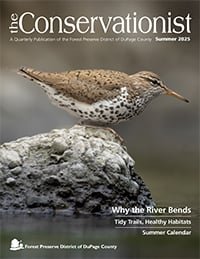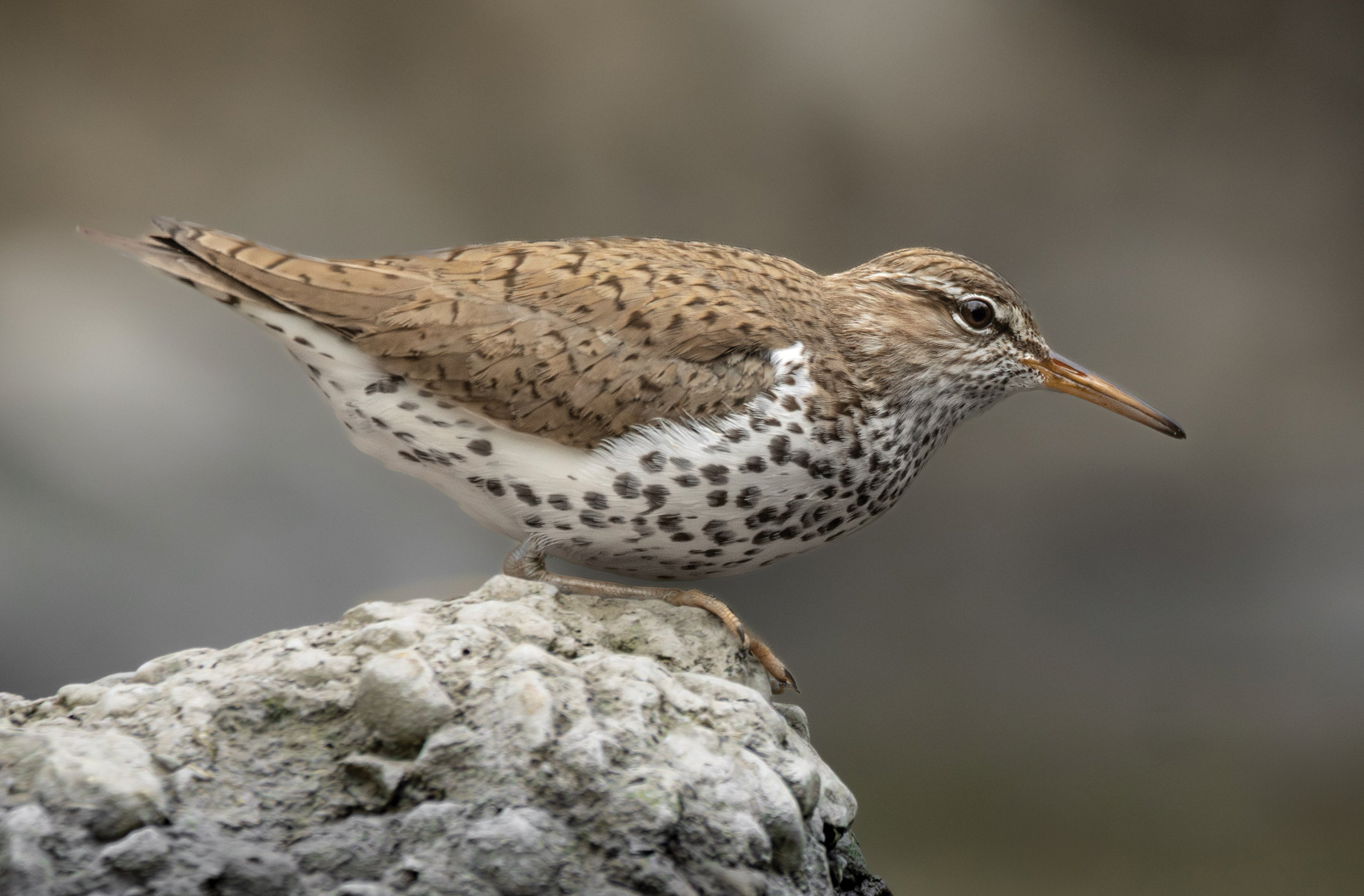
Conservationist Summer 2025
From the President

As summer arrives here in DuPage County, trees and flowers are in full bloom throughout our forest preserves, and our packed program calendar is in full swing. Long days and warm weather bring one of the busiest times of the year. With more visitors, keeping our preserves clean and safe becomes even more imperative. Thankfully, District staff and volunteers are up to the task. You can learn more about our amazing volunteers (and how to become one yourself!) in "Tidy Trails, Healthy Habitats" below.
Speaking of hard-working helpers, be on the lookout for pollinators as you explore the preserves this summer. As their nationwide habitat and population numbers decrease, the District remains committed to treating our preserves as havens for native species that protect pollinators.
While you’re out catching rays (wearing sunscreen of course!) the District will be doing likewise. Construction is set to start on a ground-mounted solar panel array at our headquarters at Danada and on the new Grounds and Natural Resources Maintenance Campus at Blackwell, which will have a powerful 500-kilowatt array to cover all the site’s electric needs. Solar power is already in use at our Fleet building at Blackwell and at the golf cart storage building at The Preserve at Oak Meadows, but leading the pack is the DuPage Wildlife Conservation Center — our first net-zero-designed facility — that has ground- and roof-mounted collectors. Each of these projects underscores our commitment to improving the quality of life for all DuPage County residents by powering our operations while drastically reducing our greenhouse gas footprint and environmental impact.
Summer 2025 is set to be an excellent one for the Forest Preserve District, so fill up your water bottle, lather up your sunscreen, keep some bug spray handy, and I’ll see you on the trails!
Daniel Hebreard
President, Forest Preserve District of DuPage County
News & Notes
Collections Corner
When you go fishing in a DuPage forest preserve, you join a long tradition.
Indigenous people lived here for thousands of years partly because fishing was so abundant. Fish that lived in the same waters we drop a line in today were a crucial part of their diet.
By the end of the 19th century, fishing in DuPage had shifted from a means of subsistence to a leisurely activity; a fishing adventure was a refreshing break from work or a peaceful weekend activity. But there was more to it than lazing away a hot afternoon, pulling bass or bluegill from the pasture creek with a worm, hook, and simple cane pole. A spinner bait (top) and reel (bottom), which are part of Kline Creek Farm’s collection, evidence a quiet pastime turning into a roaring industry.
Because of modern manufacturing, tackle and gear became increasingly affordable and available through local merchants and mail order giants like Sears, Roebuck & Company. Anglers could buy specialty rods made from steel, wood, or bamboo and quality reels machined from brass and steel. Sellers offered machine-made line of braided cotton, linen, or silk as well as snelled and treble hooks and fabricated sinkers and floats. There was also a range of artificial lures, including flies, casting spoons, spinner baits, plugs, minnows, frogs, crickets, crawfish, and, of course, worms — genuine or rubber.
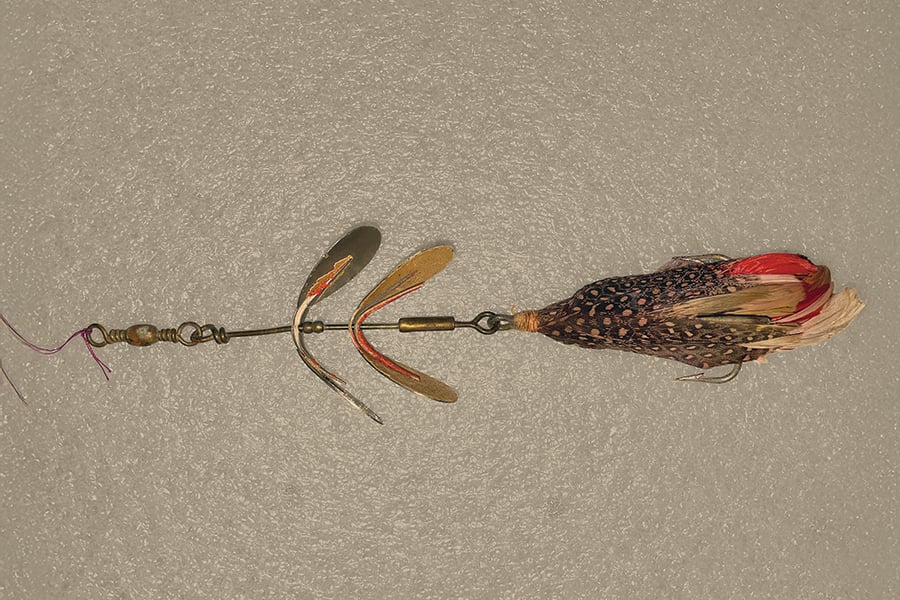
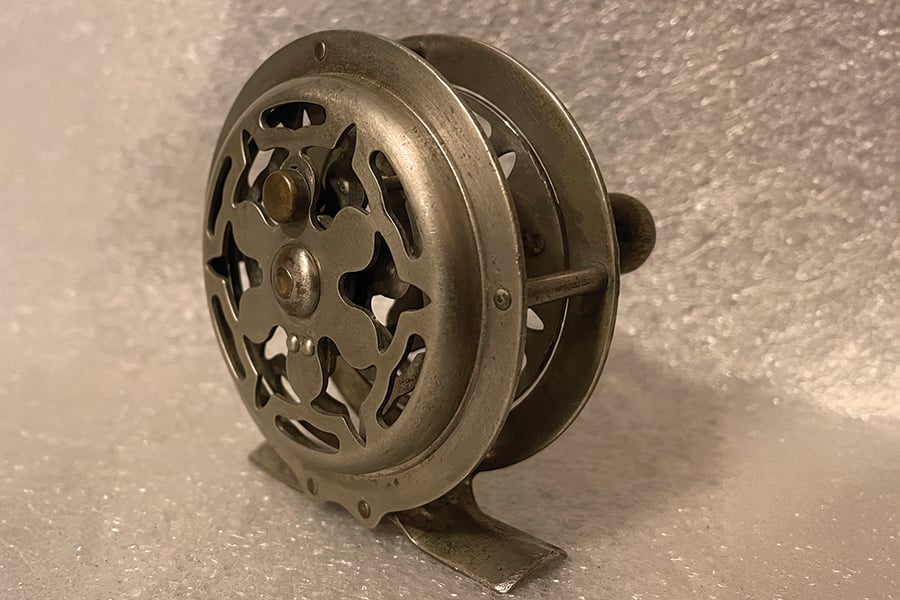
Visitor Services Saturday Phone Hours
Now through Aug. 30 (except July 5), Visitor Services is available on Saturdays 9 a.m. to 2 p.m. to answer your calls, emails, and online chats. The office won’t be open for in-person visits, but you’ll still get answers to all those questions you missed during the week.
Get in touch at 630-933-7248 or permits@dupageforest.org, or use our chat box in the lower left corner of this page.

State Grant to Help Fund New Bridge at Blackwell
The Forest Preserve District has received a $1.06 million grant from the Illinois Transportation Enhancement Program to help fund the replacement of Blackwell’s Cenacle Bridge. ITEP, an Illinois Department of Transportation initiative, supports projects that improve pedestrian and bike travel.
The bridge is part of Blackwell’s 0.6-mile Cenacle Trail, which connects Batavia Road with the regional West Branch DuPage River Trail. Engineering on the $2.2 million project is expected to start later this year with construction beginning in 2027.
Built 100 years ago, the Cenacle Bridge provided access to a Catholic retreat house that once stood on this site. After a century of spanning the West Branch DuPage River, though, the bridge has deteriorated beyond routine maintenance and no longer meets modern safety standards.
Replacing the bridge has long been a goal for the District and is a certified project under the 2019 Master Plan. In addition to the ITEP grant, the project has secured $300,000 in committed federal transportation funds and anticipates $250,000 from the Illinois Department of Commerce and Economic Opportunity.
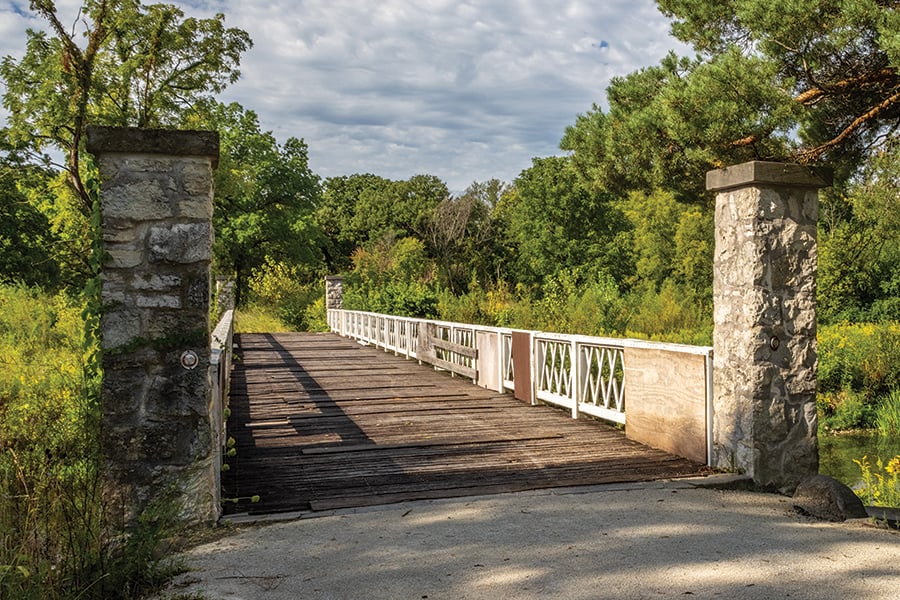
The Final Stretch at Spring Brook
This summer the Forest Preserve District will begin to restore the third and final stretch of Spring Brook at Blackwell. Crews will stabilize the streambank to prevent future erosion and replace the Cenacle Trail bridge so stormwater can flow easier downstream. Pending contract approval by the board of commissioners, the District expects work to begin in July with the majority completed by the end of the year.
The District has already restored 1.9 miles of Spring Brook through Blackwell and St. James Farm. This final 0.7-mile stretch ends where the brook flows into the West Branch DuPage River.
The Cenacle Trail will temporarily close during construction, but visitors who normally use it to reach Blackwell and the West Branch DuPage River Trail can instead use the existing trail link along Batavia and Butterfield roads. The District will post detour signs as the project progresses.
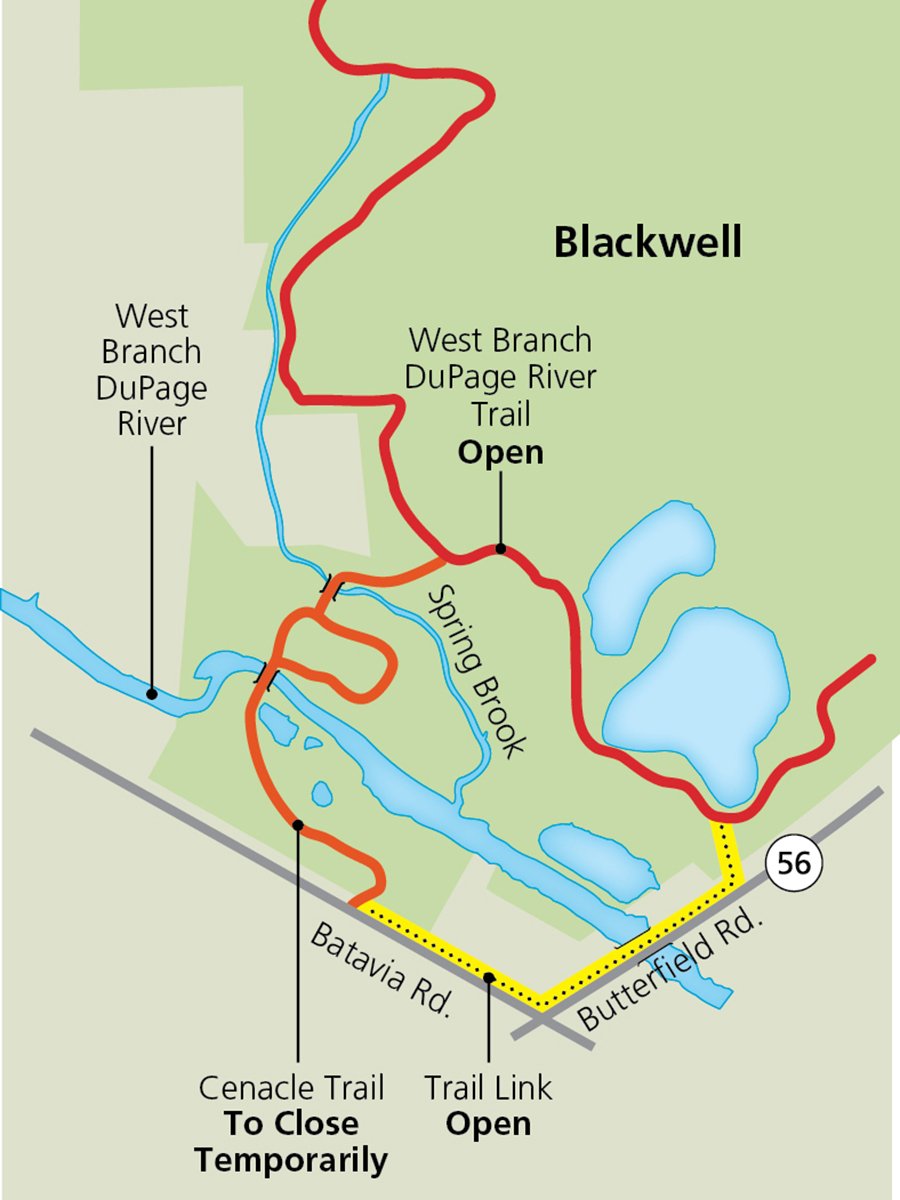
2025 Take a Hike Challenge

Thank You for Being a Friend
The Friends of the Forest Preserve District of DuPage County gratefully acknowledges those who donated $500 or more during the first quarter of 2025. The Friends engages the community in philanthropy to advance the District’s mission. Your generosity makes a difference for wildlife and wild areas in DuPage County through programs and projects.
To make a donation, discuss your giving plans or learn more, visit dupageforest.org/friends.org or contact Partnership & Philanthropy at 630-871-6400 or fundraising@dupageforest.org.
Gift of $5,000 or More
Marilyn Schweitzer and Michael Firman
Tyndale House Ministries
Gift of $2,500 – $4,999
Anonymous
Edward Jones — Financial Advisor Mike Dyer
GreenState Credit Union
Kerschen Family Fund
Kiersten Laren
Gift of $1,000 – $2,499
Anonymous (two)
Mary Ellen and Patrick Mauro
The McLean Fund
Edith M. Podrazik
Gift of $500 – $999
Anonymous (three)
Claudia and David D’Hooge
Kathy Isoda
Ronald Johnson and Lisa Savegnago
Neuco
David and Loretta Nienke
Martha and Bruce Sanders
John Schroeder
John and Maria Shalanko
David and Faith Slowinski
Why the River Bends
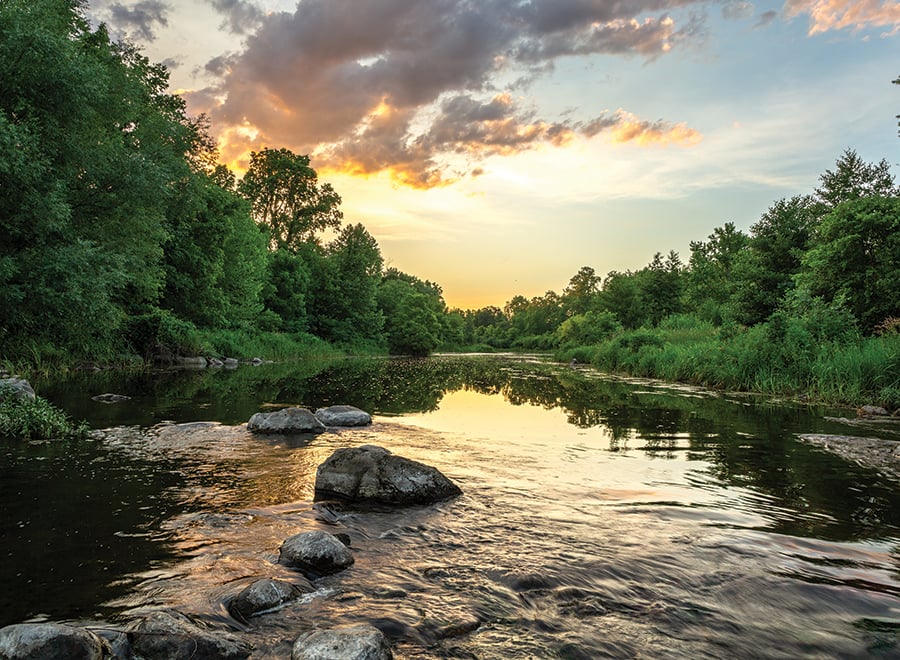
Riffles along a restored stretch of the west branch dupage river
You’re standing on skis at the peak of a steep mountain. You have two choices. You can crouch, tuck in your poles, and head straight down as fast as you can screaming “Here goes nothing!” Or you can start down the slope more slowly at an angle, first to the right and then gradually cutting back across to the left. The latter choice lets you gently weave down the slope at a more manageable speed. It also illustrates how natural rivers and streams curve and twist across the landscape in a series of bends, called meanders.
Like many land formations, a meandering river begins with a glacier. As the enormous frozen mass moves over land, its immense weight combined with the grinding action of the ice erodes the rocks and soil beneath. When the climate warms (or the glacier reaches lower, warmer elevations) and the ice melts, the resulting meltwater carries the finely ground sediment downhill. The continuous flow eventually carves channels into the land — the beginnings of a river.
Meanders follow, beginning with a slight bend in a river’s course. Water flows faster on the outside of a bend than on the inside. This difference in speed erodes the outside and deposits the sediment on the inside. Over time, this erosion makes the bend more pronounced and the river’s path more winding. In DuPage, you can see natural examples of meanders along the West Branch DuPage River in Hawk Hollow and Klein Creek at Timber Ridge.
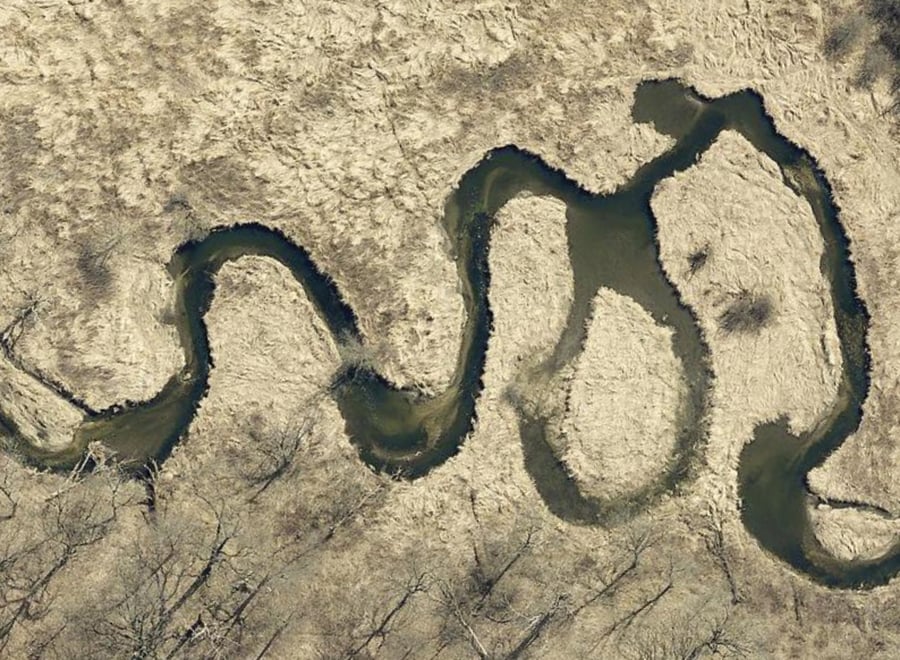
This satellite view of Klein Creek shows the twists and turns of a natural meandering stream.
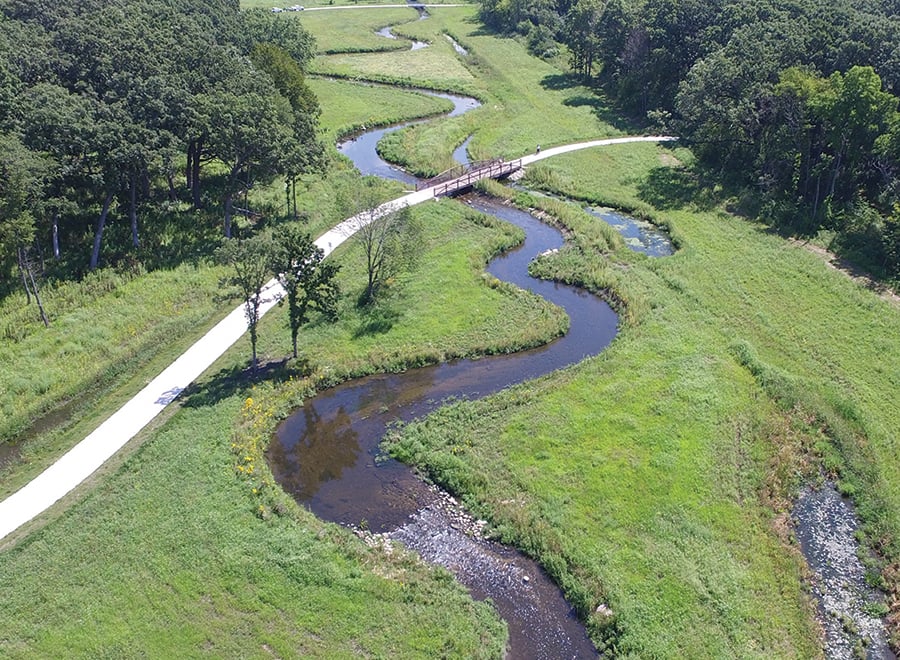
The restored Spring Brook, a tributary of the West Branch DuPage River, is again enriched with bends, riffles, and pools.
Today, though, many DuPage rivers are far from natural. In the 1830s and ‘40s, farmers wanting to create “workable” land more suitable for agriculture removed many meanders to maximize the number of acres they could plant and to make it easier for equipment to maneuver along the banks. They also deepened rivers and streams so stormwater would remain within the banks and out of their fields. In the end, they effectively turned gently winding waterways into channelized ditches.
A straight stretch of river isn’t necessarily bad. Over decades straight sections can form, albeit temporarily. But from an ecological standpoint, they often don’t feature the natural processes that benefit wildlife and humans alike.
Meandering rivers have shallow and deep areas of fast- and slow-moving water, so they attract aquatic animals with different habitat preferences. Fish like to rest in deep pools or on the edge of eddies. Dragonfly larvae, on the other hand, don’t mind hanging out in rushing riffles. Straightened rivers with more uniform conditions can’t offer this range of environments.
Winding rivers help combat water pollution and flooding, too. Because stormwater spills easily over their banks, it can settle in surrounding floodplains, where deep-rooted grasses and flowers act like sponges, soaking up water, pollutants, and excess nutrients. Any water that remains seeps slowly through filtering layers of soil and rock before reaching underground aquifers. In deepened, channelized waterways, heavy rains surge downstream unimpeded, carrying pollutants and flooding hazards with them.
Meandering waterways also have higher levels of dissolved oxygen, a must for animals like fish, mussels, tadpoles, and developing aquatic insects, which all breathe underwater. Riffles — stretches where shallow, turbulent water rushes over rocks — are primarily to thank. As the choppy current comes in contact with the air, oxygen bubbles continuously form and dissolve in the water. Channelized rivers seldom have riffles, so they’re unable to generate nearly as much dissolved oxygen.
Because of the great value of meanders, over the past four decades the Forest Preserve District has successfully returned bends to many of the county’s waterways and planted surrounding floodplains with native vegetation. Of the forest preserves’ 42 miles of rivers and streams, 32 miles have been restored with help from partners such as the DuPage River Salt Creek Workgroup and DuPage County Stormwater Division. You can see results along the West Branch DuPage River and its tributaries at West Branch, West DuPage Woods, Blackwell, Warrenville Grove, McDowell Grove, and Springbrook Prairie. At Churchill Woods there’s now a more natural-flowing East Branch DuPage River; at The Preserve at Oak Meadows and Fullersburg Woods, a revitalized Salt Creek.
An untouched river bend is the product of thousands of years of physical forces, and by understanding those forces and mimicking their results, we’ve been able to return channelized waterways to their natural selves, ensuring their stability and continued health. It’s an understanding that benefits not only our rivers but also our appreciation of the greater natural world — with all its twists and turns.
Elements of a Healthy Meandering River
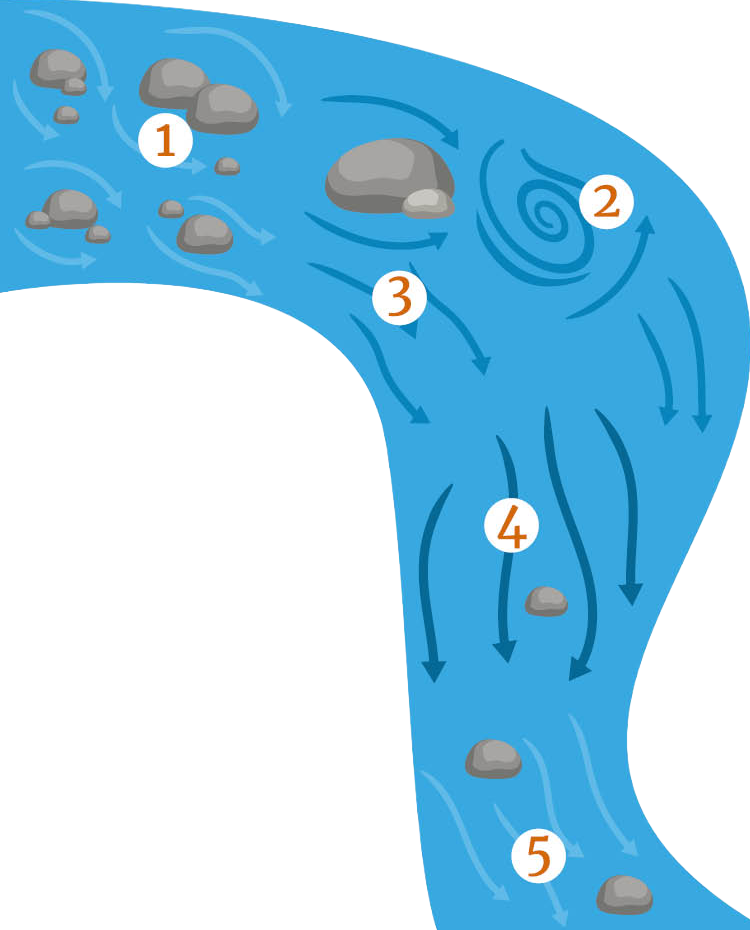
- Riffle
Shallow, fast-flowing section that tumbles over rocks. Looks bubbly and choppy. Where vital bubbles of oxygen mix into the water. - Eddy
Small whirlpool where current reverses course. Forms behind obstacles like rocks or logs. - Run
Smooth, swift current with more uniform flow. Usually deeper than a riffle and without the chop. Gradual increase in elevation as you “run” down into a pool. - Pool
Like a smooth mini pond within a river. Deeper outer area of a meander where water slows and fish often overwinter. - Glide
Relatively smooth-flowing section after a pool. Some gentle waves but not as broken up as a riffle. Gradually shallows as you “glide” out of a pool.
Tidy Trails, Healthy Habitats
Picture your most recent visit to a forest preserve. You’re breathing in the fresh air, feeling your worries wash away as you take in nature’s beauty. Moments like these are why so many people love the preserves, but behind the scenes many hidden helpers — staff, partner organizations, volunteers — are working hard to keep the preserves clean for visitors and wildlife alike. So, who are some of these hidden helpers and why does their work matter?
Hidden Helpers: Volunteers on the Trail
If you’re frequently in the preserves, you’ve likely noticed the work of these hidden helpers who keep trails clean and safe on a daily basis.
Donned in orange reflective vests, Clean-Up Crew volunteers collect litter from forest preserve trails, waterfronts, and roadsides. In 2024 alone they picked up over 600 bags of trash!
“For my whole adult life, I’ve visited and taken advantage of many of our county forest preserves, and I’ve been grateful that local residents have such a great outdoor resource,” 10-year Clean-Up Crew volunteer David Y. said. “What I like about individual Clean-Up Crew is that it is totally unplanned and discretionary, so if my mood and the weather suit, I can simply gather my gear and go out for however long I like. And when I hike or drive past one of the preserves myself, I enjoy noting that the place looks good!”
David collected 189 bags in 2024. His single largest haul was from Belleau Woods: 18 bags of litter and a car tire.
If you encounter someone in a tan vest, you’ve just met a Trail Watch volunteer. These dedicated people walk or bike in pairs or small groups and report hazards or incidents to the Forest Preserve District, often collecting litter along the way.
Community and corporate groups volunteer their time as well. NOW Foods, a natural health company, has donated over 2,400 hours over the past 25 years. During their annual after-work clean-up, employees and their families volunteer together at East Branch, which is less than a half mile from their office. Efforts like theirs make a difference: In 2024, group volunteers collected 350 bags of litter in DuPage forest preserves.
It Adds Up
One wrapper or bottle might not seem like much, but each piece contributes to a bigger problem. A 2021 report from Keep America Beautiful estimates there are 152 pieces of litter in the U.S. for every person who lives here. Do you think you could pick up that much garbage every year?

Unexpected Litter Learning Moments
While our preserves hold hidden natural treasures, such as rare native plants or camera-shy wildlife, some visitors find unanticipated discoveries. Last summer, elementary-aged campers exploring Fullersburg Woods were surprised to find human artifacts that had made their way down Salt Creek. From an old sun dial to an anchor to old glass soda bottles, there was no shortage of treasures! But along the shoreline some finds were purely trash — bottle caps, straws, chip bags. As the campers pitched in to clean up, they questioned how litter got into the creek and how they could prevent it from getting there in the first place.
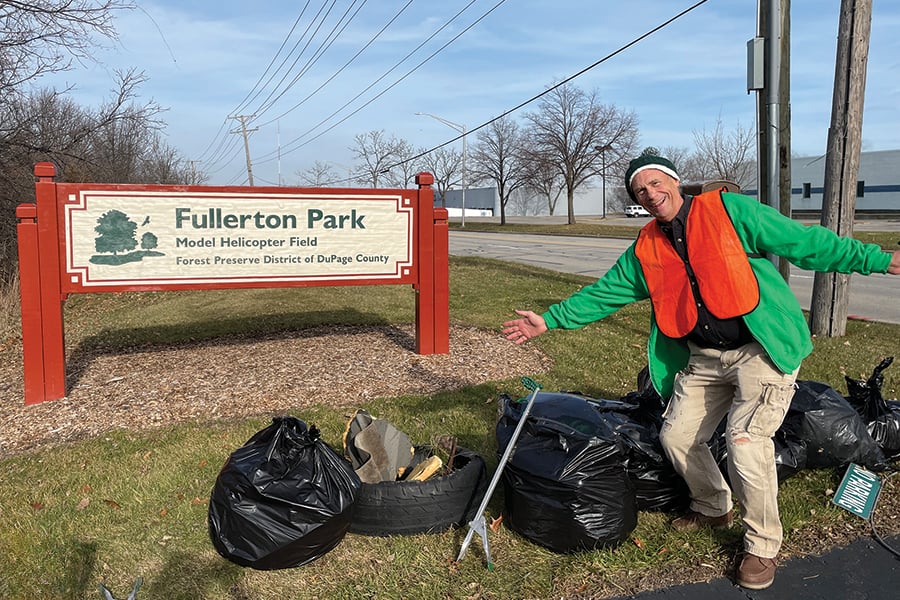
Just a few people volunteering for a couple of hours can have a dramatic effect on the landscape of a forest preserve.
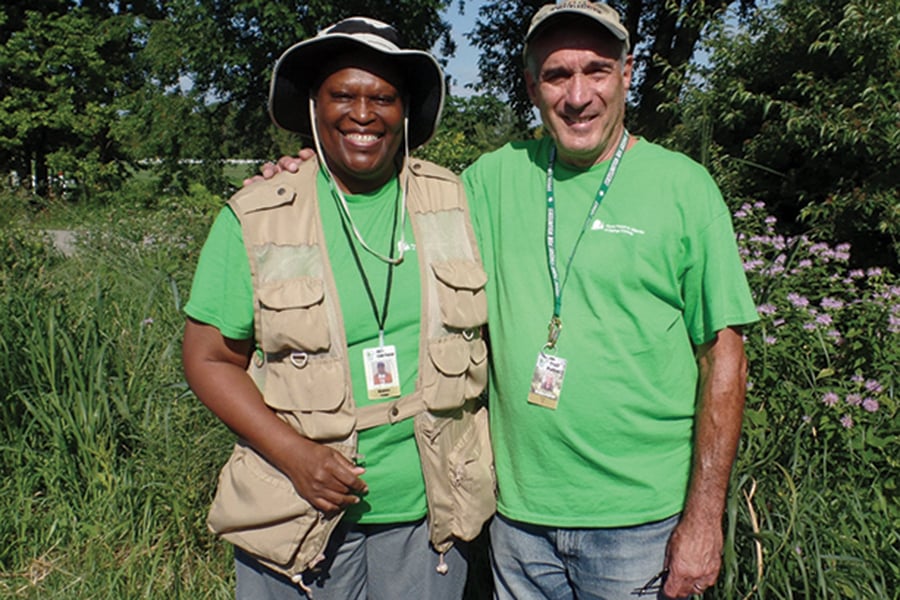
Trail Watch volunteers answer visitors’ questions and keep an eye open for hazards on the trails.
Real Consequences: How Trash Affects Wildlife
Litter — be it trash or treasure — not only pollutes land and water, it can also harm individual wild animals. Animals mistaking litter for food may eat it, resulting in blocked airways or digestive tracks, poisoning, or even death. Wildlife can also get tangled up in plastic bags or fishing line, restricting movement and possibly causing injury or death.
Over the years the Forest Preserve District’s DuPage Wildlife Conservation Center has treated hundreds of animals injured by littered bags, fishing line and lures, and plastic and glass containers. The new visitor center, which opens later this year, will feature exhibits that address the hazards of litter and simple ways we can all help keep local wildlife healthy.
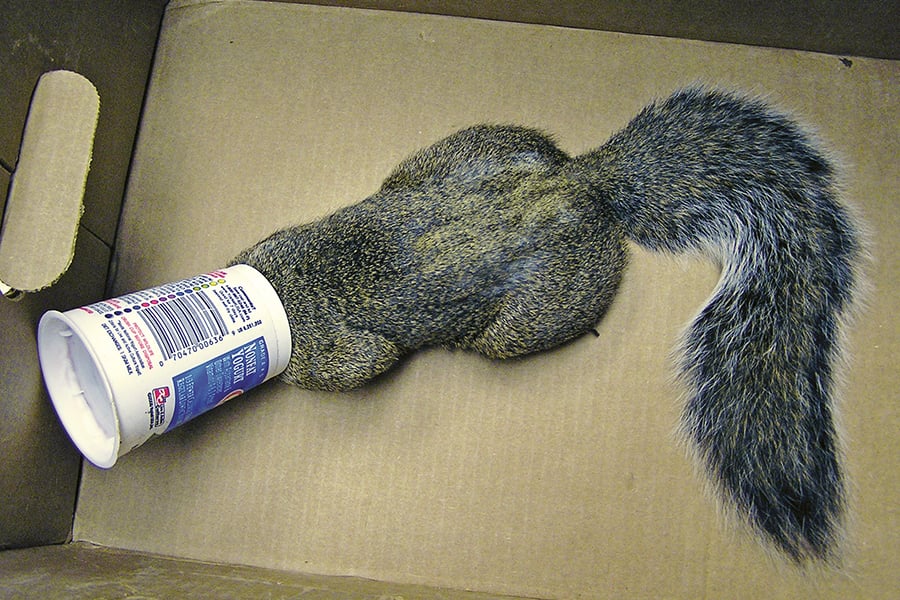
Litter can harm individual animals. (This particular squirrel was successfully freed and released back into the wild.)
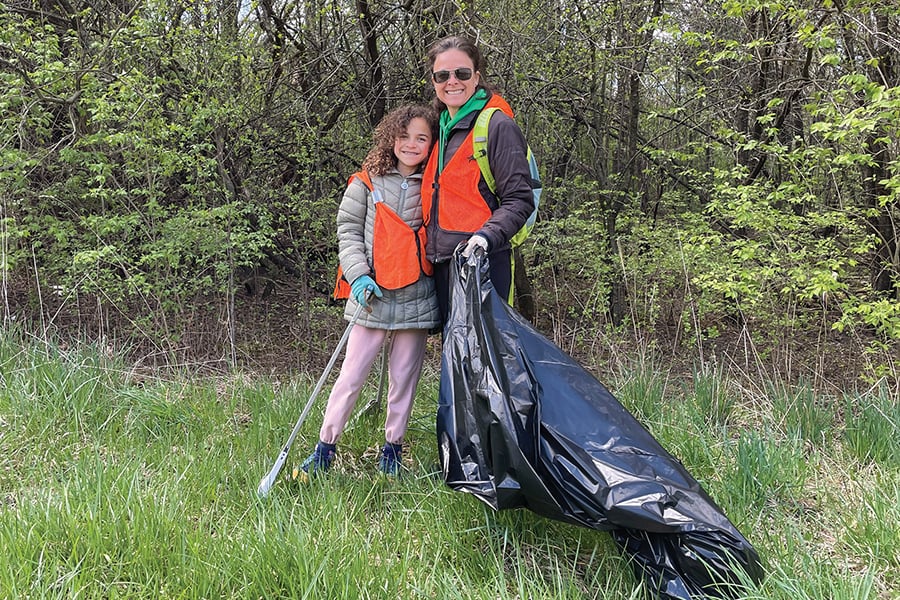
Volunteering with the Clean-Up Crew is a great way to spend time together while helping a good cause.
Ways to Help While Enjoying the Preserves
There are a few easy ways you can do your part as you visit.
Leave no waste. Keep any garbage with you until you find a trash or recycling bin. In most preserves they’re by the parking lots.
Pick up trash. Bring a bag and gloves on your next visit to help clean up litter.
Stay on the trails. Stick to designated paths to protect plant life and prevent erosion.
Report issues. Let the Forest Preserve District know about hazards or unusual sightings. You can do so at dupageforest.org. Just click on “Report a Concern.”
Respect wildlife. Observe animals from a distance, and avoid disturbing their habitats.
How to Volunteer
The Forest Preserve District offers lots of ways to pitch in and make a difference! Join our Clean-Up Crew, where you can clean trails, roadsides, and waterways on your own schedule. Organize your friends, family, or coworkers for a group clean-up day, a rewarding way to spend time together while helping the environment. Mark your calendar for our “County Trash Sweep” Sept. 20, and visit our Volunteer page for more opportunities. We look forward to seeing you soon!
